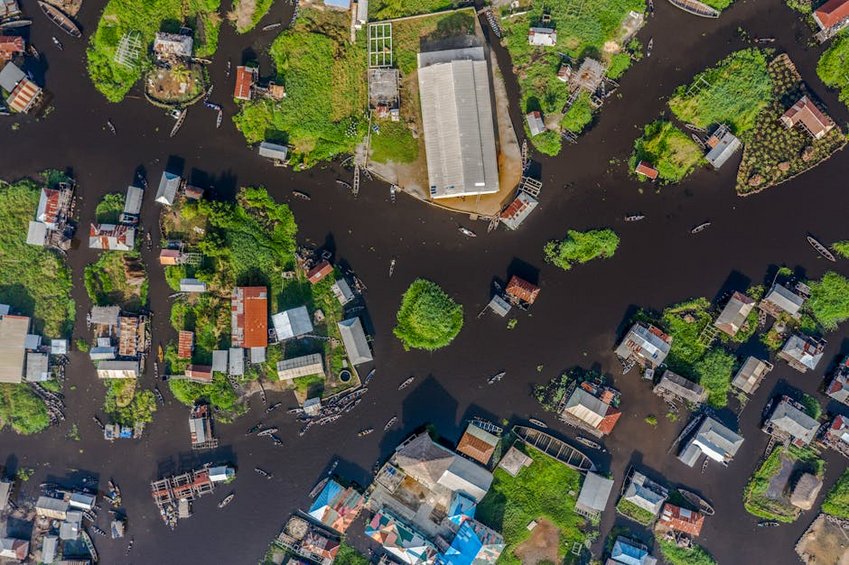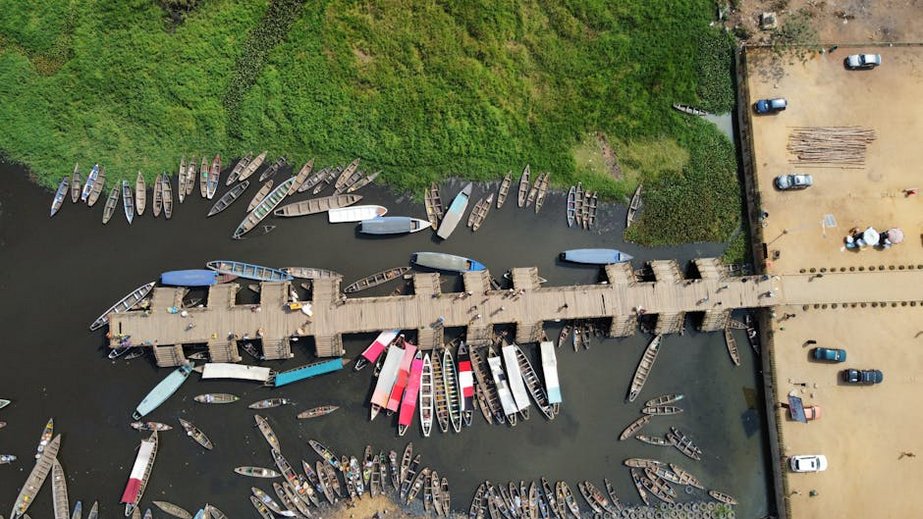Discover the Unique Charm of Benin Ganvie Stilt Village
Imagine gliding through tranquil waters in a wooden canoe, surrounded by a vibrant community living entirely on stilts—this is the unforgettable experience awaiting you at Benin Ganvie Stilt Village. Nestled on Lake Nokoué in West Africa, this remarkable settlement is often called the “Venice of Africa” and stands as one of the largest stilt villages in the world. Founded centuries ago by the Tofinu people seeking refuge from slave traders, Benin Ganvie Stilt Village offers a fascinating glimpse into a unique way of life where daily activities, from fishing to schooling, unfold over water. You’ll be captivated by the colorful wooden houses, bustling floating markets, and the gentle rhythm of canoe traffic that defines this aquatic community. Visiting Benin Ganvie Stilt Village isn’t just a trip; it’s an immersion into a culture deeply connected to its environment, making it a must-see for adventurous travelers seeking authentic experiences. As you plan your journey, you’ll discover how this village blends history, resilience, and natural beauty, creating memories that will last a lifetime.
Benin Ganvie Stilt Village – Essential Information
Before you embark on your adventure to Benin Ganvie Stilt Village, it’s crucial to understand its foundational aspects. Located about 15 kilometers north of Cotonou, Benin’s economic hub, this village spans approximately 20 square kilometers and is home to over 20,000 residents who live in houses built on wooden stilts driven into the lakebed. The community thrives on fishing, with tilapia and other local species forming the backbone of their economy, and you’ll notice canoes serving as the primary mode of transportation. Benin Ganvie Stilt Village was established in the 16th or 17th century by the Tofinu ethnic group, who sought protection from Fon warriors by building their homes on water, and today, it represents a UNESCO World Heritage tentative site due to its cultural significance. As a visitor, you’ll appreciate how the village has preserved its traditions while adapting to modern influences, such as solar-powered lights and limited internet access. Understanding this background will enrich your experience, allowing you to connect more deeply with the local way of life and appreciate the ingenuity behind this aquatic settlement.
What is Ganvie Stilt Village? – A Detailed Overview
- Benin Ganvie Stilt Village is a fully functional community built entirely over water, featuring homes, schools, and markets on stilts, making it a unique destination for cultural immersion and photography.
- The village relies on canoe transport for everything from daily commutes to goods delivery, and you can hire local guides for tours that highlight its history and daily routines.
- Key features include floating gardens, a central market where vendors sell fresh fish and crafts from their canoes, and religious sites like the village church, all showcasing the Tofinu people’s adaptation to their environment.
- Budget travelers can expect to spend around $50-100 USD per day, covering basic guided tours, canoe rentals, and meals in Cotonou, with options like group tours reducing costs.
- Mid-range options cost $100-200 USD daily, including private guides, comfortable accommodations in Cotonou, and additional activities like extended village tours or cultural performances.
- Luxury experiences range from $200-400 USD per day, featuring all-inclusive packages with premium guides, boutique hotels, and personalized itineraries that might include photography workshops or exclusive access to local events.
- Official Benin Tourism Board
- Lonely Planet Benin Travel Guide
Historical Background and Cultural Significance
The history of Benin Ganvie Stilt Village dates back to the 1600s when the Tofinu people, fleeing the slave trade led by the Dahomey Kingdom, chose Lake Nokoué as a sanctuary because their pursuers believed water was inhabited by spirits and avoided it. Over generations, they developed sophisticated techniques for building stilt houses using locally sourced wood and palm fronds, creating a sustainable lifestyle centered around fishing and aquaculture. Culturally, the village embodies resilience and community cohesion, with traditions passed down through oral storytelling, festivals, and rituals honoring water deities. For you as a traveler, this history adds layers of meaning to your visit, as you’ll witness how the residents maintain their heritage while navigating challenges like erosion and climate change. By learning about these aspects, you’ll gain a deeper appreciation for why Benin Ganvie Stilt Village is not just a tourist attraction but a living testament to human adaptability.

Benin Ganvie Stilt Village – Planning Your Trip
Planning a visit to Benin Ganvie Stilt Village requires careful consideration of timing, budget, and logistics to ensure a smooth and enriching experience. As an off-the-beaten-path destination, it’s essential to arrange your trip through reputable tour operators in Cotonou, who can provide guided canoe tours and handle permits, as independent access is limited. You’ll need to account for transportation from Cotonou, which typically involves a short drive to the lake’s edge followed by a canoe ride, and it’s wise to book accommodations in advance, either in Cotonou or nearby guesthouses, as overnight stays in the village are rare. Budget-wise, Benin Ganvie Stilt Village visits can range from affordable day trips to more comprehensive packages, so we’ll break down costs later. Additionally, consider health precautions like vaccinations for yellow fever and malaria prophylaxis, as Benin is in a tropical region. By planning ahead, you’ll maximize your time exploring this unique community and avoid common pitfalls, such as language barriers or unexpected weather changes.
Best Time to Visit Ganvie Stilt Village
The ideal time to visit Benin Ganvie Stilt Village is during the dry season, from November to March, when rainfall is minimal, and water levels are stable, making canoe tours more comfortable and allowing for clearer views of the stilt houses. During this period, temperatures range from 25°C to 32°C (77°F to 90°F), and you’ll enjoy sunny days perfect for photography and outdoor activities. Alternatively, the rainy season from April to October brings lush greenery and fewer tourists, but heavy rains can cause flooding and make navigation challenging, so if you prefer a quieter experience, aim for early dry season months like November. Keep in mind that local festivals, such as fishing celebrations in December, add cultural vibrancy but may require advance booking. Ultimately, aligning your visit with the dry season ensures you’ll have the best overall experience at Benin Ganvie Stilt Village, with optimal conditions for exploring and engaging with the community.
Budget Planning and Costs
Essential Preparation Checklist
To prepare for your trip to Benin Ganvie Stilt Village, start by securing necessary travel documents, including a visa for Benin, which most Western passport holders can obtain on arrival or online, and ensure your passport is valid for at least six months. Pack lightweight, breathable clothing for the humid climate, along with a rain jacket for sudden showers, sturdy shoes for getting in and out of canoes, and insect repellent to protect against mosquitoes. It’s also wise to bring cash in West African CFA francs, as credit cards are rarely accepted in the village, and learn a few basic phrases in French or the local Goun language to facilitate communication. Health-wise, consult your doctor for recommended vaccinations and carry a basic first-aid kit. By following this checklist, you’ll be well-equipped to enjoy Benin Ganvie Stilt Village safely and comfortably, focusing on the incredible sights and sounds rather than logistical hassles.
Benin Ganvie Stilt Village – Top Attractions and Activities
Once you arrive at Benin Ganvie Stilt Village, you’ll be spoiled for choice with a variety of attractions and activities that highlight its unique aquatic lifestyle. A guided canoe tour is the centerpiece of any visit, allowing you to navigate the labyrinthine waterways, observe daily life up close, and interact with friendly locals who often share stories about their heritage. Must-see spots include the vibrant floating market, where vendors sell fresh fish, fruits, and handmade crafts directly from their boats, and the village school, where children learn in classrooms perched above the water. For a more immersive experience, consider joining a fishing demonstration to see traditional techniques in action or visiting during a festival to witness colorful ceremonies and dances. As you explore, you’ll notice how every aspect of Benin Ganvie Stilt Village is adapted to its environment, from the stilt-supported homes to the community’s reliance on sustainable practices. This section will guide you through the highlights and hidden gems, ensuring you don’t miss any of the unforgettable moments this destination offers.
Must-See Highlights
Among the top attractions in Benin Ganvie Stilt Village, the floating market stands out as a dynamic hub of activity where you can barter for souvenirs like wooden carvings or sample local snacks from canoe-based vendors. Another highlight is the central “place” or gathering area, often used for community events, where you might catch a glimpse of traditional music performances or religious ceremonies. Don’t miss the opportunity to visit a family home—many residents welcome tourists for a small fee, giving you insight into their daily routines and the clever design of stilt houses, which include raised platforms to avoid flooding. Additionally, the village’s church and mosque, both built on stilts, showcase the religious diversity and architectural ingenuity of the community. These highlights provide a comprehensive view of life in Benin Ganvie Stilt Village, blending cultural education with visual splendor that you’ll cherish long after your trip ends.
Hidden Gems and Local Favorites
Beyond the main attractions, Benin Ganvie Stilt Village hides several lesser-known gems that offer a more intimate experience. For instance, venture to the quieter northern sections of the lake, where you can observe artisans crafting fishing nets or building canoes using age-old methods passed down through generations. Local favorites include early morning canoe rides to watch the sunrise over the village, casting a golden glow on the stilt houses and creating perfect photo opportunities, or visiting during the weekly fish smoking sessions, where you can learn about preservation techniques and even try your hand at the process. Another hidden spot is the “secret” garden areas where families grow vegetables on floating rafts, demonstrating innovative agricultural practices. By seeking out these experiences, you’ll gain a deeper connection to Benin Ganvie Stilt Village and its people, moving beyond the tourist trail to discover the authentic heart of this aquatic community.
Benin Ganvie Stilt Village – Practical Travel Information
Navigating the practical aspects of your trip to Benin Ganvie Stilt Village is key to a stress-free adventure, starting with transportation. Most visitors fly into Cotonou’s Cadjehoun Airport, which has connections from Europe and other African hubs, and then take a taxi or arranged transfer to the lakefront, where you’ll hire a canoe for the final leg to the village. Once there, canoes are the only way to get around, so be prepared for water-based travel and discuss routes with your guide to cover key areas efficiently. Accommodation options are primarily in Cotonou, ranging from budget hostels to upscale hotels, but if you’re seeking a unique stay, some tour operators offer homestays or eco-lodges near the lake. Safety-wise, Benin Ganvie Stilt Village is generally secure, but it’s advisable to travel with a guide, avoid flashy jewelry, and respect local customs to ensure a positive experience. This section will provide detailed insights into getting there, staying comfortable, and making the most of your time in this extraordinary setting.
| Category | Options/Features | Price Range (USD) |
|---|---|---|
| Accommodation | Budget hotels in Cotonou with basic amenities, mid-range options with AC and Wi-Fi, luxury resorts with lake views | $30-150 per night |
| Transportation | Taxi from airport to lakefront, canoe rentals per hour or day, guided tour packages including transport | $10-50 per person |
| Activities | Basic village tour, extended fishing experiences, cultural workshops, photography tours | $20-100 per activity |


